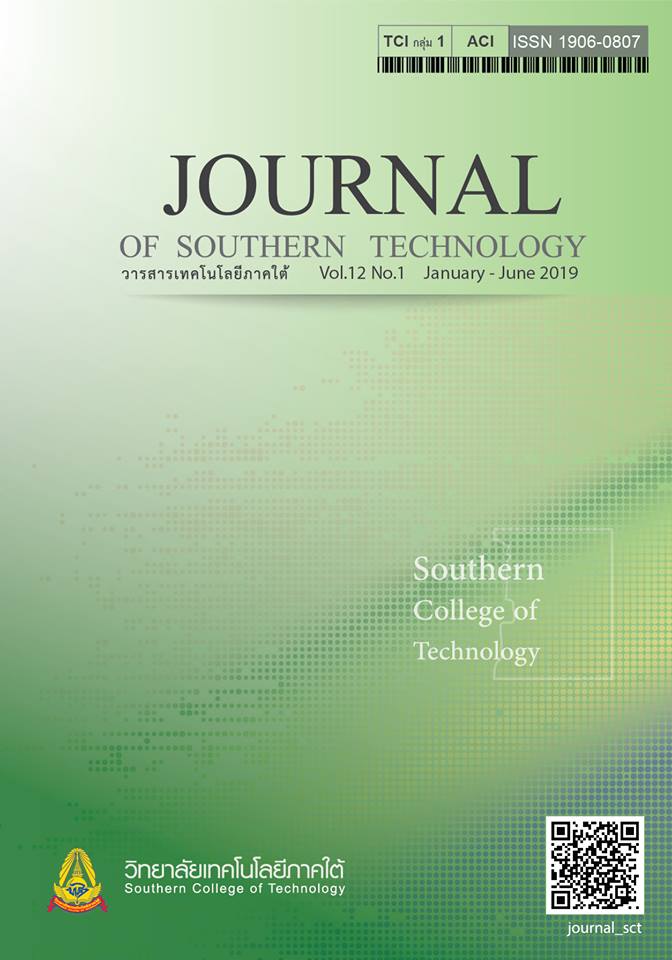Design of Learning Styles Using Internet of Thing (IoT) and Cloud Computing to Support Meaningful Learning for Higher Education Students
Main Article Content
Abstract
The purposes of this research were to 1) develop learning model using the Internet of Thing (IoT) and Cloud Com-putting to support meaningful learning and 2) evaluate the learning model using the Internet of Thing and Cloud Computing to support meaningful learning of higher education students. The evaluation of the newly developed learning model was conducted by 7 experts in the field of Education and the field of Information Communication Technology in Education. Research instrument was an evaluation form of the newly designed learning model. Data were analyzed using content analysis, percentage, mean and standard deviation. The results showed that the newly developed learning model was highly appropriate. The learning model comprised 3 parts. Part 1 Smart Teaching includes 7 steps of teaching for meaningful learning: 1) Recommend, 2) Survey, 3) Present, 4) Separate, 5) Connecting Teaching, 6) Advance Organizer and 7) Compose. Part 2 Smart Classroom concerns the application of IoT to build a smart classroom with 3 facility systems: IoT Smart Check in, IoT Smart Cam and IoT Smart Office. Part 3 Smart Learning is the use of personal devices e.g. smart phone, tablet, laptop and other smart mobile devices to connect with Cloud Computing learning.
The results reveal that the appropriateness of the newly developed model was at the highest level ( = 4.57, S.D.=0.55). When examining each individual aspect it was found that 1) Smart Teaching was rated at the highest level (
= 4.52, S.D.=0.52), 2) Smart Classroom was rated at the highest level (
= 4.61, S.D.= 0.62) and 3) Smart Learning was rated at the highest level (
= 4.67, S.D.= 0.52). Based on the results, it can be concluded that the developed model can be applied with significant components: Part 1) Smart Teaching should be taught thoroughly and in part 2) Smart Classroom and 3) Smart Learning can be adjusted to increase flexibility based on relevant factors, such as budget, equipment or technology, and the context of the learners.
Article Details
-
Authors must agree to the journal publication rules and allow the editors to edit the manuscripts for publication.
-
Author’s right belongs to the author but Journal of Southern Technology holds the right of first publication and thus allow readers to use the article for the purpose of education but not commercial.
References
Administer Department of Mahidol Wittayanusorn School. (2010). National Education Act, BE
(2000), Amended (No. 2), BE 2545. Retrieved August 25, 2017, from: https://person.mwit.ac.th/01-
Statutes/National Education.pdf.
Ausubel, D. P. (1963). The Psychology of Meaningful Verbal Learning. New York: Grune & Stratton.
Claro, M. (2010). “Impacto de las TIC en los aprendizajes de los estudiantes. Estado del arte.” Santiago de Chile: Naciones Unidas. Retrieved July 5, 2017, from: https://www.eclac.org/publicaciones/xml/7/40947/
dpimpacto-tics-aprendizaje.pdf
Delgado, H. D. (2018). Meaningful Learning Outcomes of an Educational Innovation Based on Instructional Video in a Colombian School of Medicine. Retrieved April 27, 2017, from: https://www.unab.ed
u.co/sites/default/files/MemoriasGrabadas/papers/capitulo6_paper_22.pdf
Fombona, J., Pascual-Sevillano, M.-A., & González Videgaray, M.C. (2017). M-learning and augmented reality: a review of the scientific literature on the WoS repository. Media Education Research Journal, 52
(XXV), 63-71.
Gutman, M., Steiner, D., & Mendelo- Vich, M. (2016). ICT in science education: A new language of meaningful learning or a visual gimmick? Teacher perceptions of ICT’s strengths and weaknesses. African Educational
Research Journal, 4(2), 76-84.
Janthon, A.T. (2015). Intelligent Classroom with the 21st Century Learning Management. Retrieved March 5, 2017, from: https://uaaree.dusit.ac.th/wp-content/uploads/2015/12/.
Jeerungsuwan, N. (2015). Instructional Design and Assessment. Bangkok: Textbook Production Center. King Mongkut’s University of Technology North Bangkok. [in Thai]
Kanjanatham, C., & Chanetiyoung, D. (2015). The development of information and communication technologies (ICT) model on management education in school under Chanthaburi Primary Educational Service Area, Office 2. Journal of Education, Mahasarakham University, 9(Special Issue), 109-116. [in Thai]
Kongrugsa, N. (2014). Cloud computing teaching in the 21st century. Journal of Vocational and Technical Education (JVTE), 4(7), 52-59. [in Thai]
Kunhawek, A. (2016). Meaning of Smart Home. Retrieved September 6, 2017, from: https://www.arm.co.th/Knowledge.aspx?id=2)
Pernaa, J., & Aksela, M. (2008). Concept Maps as Meaningful Learning Tools in a Web–Based Chemistry Material. Concept Mapping: Connecting Educators Proceedings of the International. Conference on Concept
Mapping Tallinn: (pp. 1-8). Estonia & Helsinki, Finland.
Rujivipat, A. (2016). Internet of things: another evolution of the internet world connect devices anywhere, anytime. Enjoy MAGAZINE Journal, (27), 20-23.
Sarnok, K. (2016). Development of 21st Century Learning Skills for Gen Z Learners Using AL Teaching. In Symposium: Education for 21st Century Skills (pp. 301-312). Nakhon Ratchasima: Chateau de Khaoyai Hotel & Resort, Nakhon Ratchasima Province. [in Thai]
______. (2017). IoE Links Everything to Smart Classroom 4.0. In National Academic Conference on Education 3th: NACE 2017 (pp. 321-334). Lampang: Road Hiran Hall Lampang Rajabhat University, Lampang
Province. [in Thai]
Siraphatthada, Y. (2010). The Learning behavioural and effectiveness Development of Students
in Principles of Marketing Study by the Active Learning Teaching (Research Report).
Institute for Research and Development. Suan Sunandha Rajabhat University.
[in Thai]
Sisaard, B. (2002). Preliminary Research. Bangkok: Wattanapanit. [in Thai]
Stufflebeam, D. L., & Shinkfield, A. J. (2007). Evaluation Theory, Models & Applications.
San Francisco, CA., John Wiley & Sons.
Valcárcel, A. (2002). “Tecnología educativa: características y evolución de una disciplina.” Revista Educación y Pedagogía, Retrieved April 12, 2017, from: https://aprendeenlinea.udea.edu.co/revistas/index.php/revistaeyp/
article/view /5572/4995
Wongyai, W. (2016). Evaluation paradigm learn in the 21st Century. SIKKHA Journal of Education, 3(1), 3-6. [in Thai]

